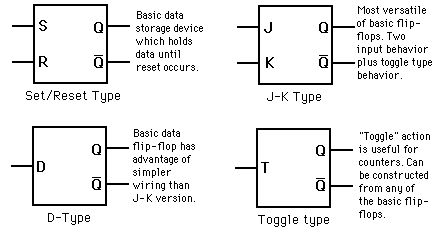- Back to Home »
- Flip Flop
Flip Flop
"Flip-flop" is the common name given to two-state devices which offer basic memory for sequential logic operations. Flip-flops are heavily used for digital data storage and transfer and are commonly used in banks called "registers" for the storage of binary numerical data.
RS (RESET-SET) FLIP-FLOP:
The fundamental latch is the simple RS flip-flop (also commonly known as SR flip-flop), where R and S stand for reset and set, respectively. It can be constructed from a pair of cross-coupled NAND or NOR logic gates. The stored bit is present on the output marked Q.
Normally, in storage mode, the R and S inputs are both low, and feedback maintains the Q and Q outputs in a constant state, with Q the complement of Q. If S is pulsed high while R is held low, then the Q output is forced high, and stays high even after S returns low; similarly, if R is pulsed high while S is held low, then the Q output is forced low, and stays low even after R returns low.
The next-state equation of the RS flip-flop is
where Q is the current state. Qnext becomes Q (the stored value) at clock edge.
RS Flip-Flop operation (BUILT WITH NOR GATES)
Characteristic table Excitation table
S R Action Q(t) Q(t+1) S R Action
0 0 Keep state 0 0 0 X No change
0 1 Q = 0 1 0 0 1 reset
1 0 Q = 1 0 1 1 0 set
1 1 Race Condition 1 1 X 0 No Change










